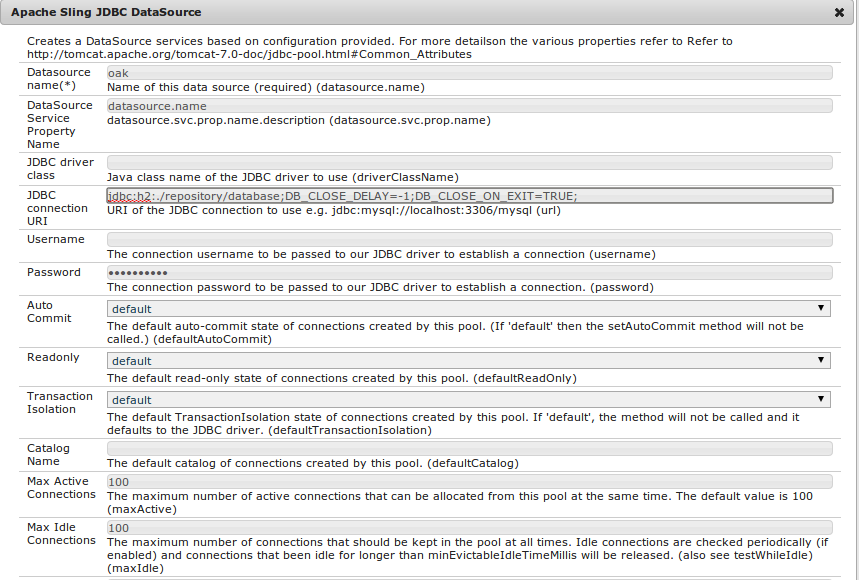Documentation moved to Apache site
git-svn-id: https://svn.apache.org/repos/asf/sling/trunk@1652376 13f79535-47bb-0310-9956-ffa450edef68
diff --git a/README.md b/README.md
index 0da8c3e..5a8a4b3 100644
--- a/README.md
+++ b/README.md
@@ -1,106 +1,5 @@
# Apache Sling DataSource Provider
-DataSource provider bundle supports two type of DataSource
+Refer to [DataSource Provider][1]
-1. Pooled Connection DataSource
-2. JNDI DataSource
-
-## Pooled Connection DataSource Provider
-
-This bundle enables creating and configuring JDBC DataSource in OSGi environment based on
-OSGi configuration. It uses [Tomcat JDBC Pool][1] as the JDBC Connection Pool provider.
-
-1. Supports configuring the DataSource based on OSGi config with rich metatype
-2. Supports deploying of JDBC Driver as independent bundles and not as fragment
-3. Exposes the DataSource stats as JMX MBean
-4. Supports updating of DataSource connection pool properties at runtime without restart
-
-### Driver Loading
-
-Loading of JDBC driver is tricky on OSGi env. Mostly one has to attach the Driver bundle as a
-fragment bundle to the code which creates the JDBC Connection.
-
-With JDBC 4 onwards the Driver class can be loaded via Java SE Service Provider mechanism (SPM)
-JDBC 4.0 drivers must include the file META-INF/services/java.sql.Driver. This file contains
-the name of the JDBC driver's implementation of java.sql.Driver. For example, to load the JDBC
-driver to connect to a Apache Derby database, the META-INF/services/java.sql.Driver file would
-contain the following entry:
-
- org.apache.derby.jdbc.EmbeddedDriver
-
-Sling DataSource Provider bundles maintains a `DriverRegistry` which contains mapping of Driver
-bundle to Driver class supported by it. With this feature there is no need to wrap the Driver
-bundle as fragment to DataSource provider bundle
-
-
-### Configuration
-
-1. Install the current bundle
-2. Install the JDBC Driver bundle
-3. Configure the DataSource from OSGi config for PID `org.apache.sling.datasource.DataSourceFactory`
-
-If Felix WebConsole is used then you can configure it via Configuration UI at
-http://localhost:8080/system/console/configMgr/org.apache.sling.datasource.DataSourceFactory
-
-
-
-Using the config ui above one can directly configure most of the properties as explained in [Tomcat Docs][1]
-
-### Convert Driver jars to Bundle
-
-Most of the JDBC driver jars have the required OSGi headers and can be directly deployed to OSGi container
-as bundles. However some of the drivers e.g. Postgres are not having such headers and hence need to be
-converted to OSGi bundles. For them we can use the [Bnd Wrap][2] command.
-
-For example to convert the Postgres driver jar follow the steps below
-
- $ wget https://github.com/bndtools/bnd/releases/download/2.3.0.REL/biz.aQute.bnd-2.3.0.jar -O bnd.jar
- $ wget http://jdbc.postgresql.org/download/postgresql-9.3-1101.jdbc41.jar
- $ cat > bnd.bnd <<EOT
- Bundle-Version: 9.3.1101
- Bundle-SymbolicName: org.postgresql
- Export-Package: org.postgresql
- Include-Resource: @postgresql-9.3-1101.jdbc41.jar
- EOT
- $ java -jar bnd.jar bnd.bnd
-
-In the steps above we
-
-1. Download the bnd jar and postgres driver jar
-2. Create a bnd file with required instructions.
-3. Execute the bnd command
-4. Resulting bundle is present in `org.postgresql-9.3.1101.jar`
-
-## JNDI DataSource
-
-While running in Application Server the DataSource instance might be managed by app server and registered with
-JNDI. To enable lookup of DataSource instance from JNDI you can configure `JNDIDataSourceFactory`
-
-1. Configure the DataSource from OSGi config for PID `org.apache.sling.datasource.JNDIDataSourceFactory`
-2. Provide the JNDI name to lookup from and other details
-
-If Felix WebConsole is used then you can configure it via Configuration UI at
-http://localhost:8080/system/console/configMgr/org.apache.sling.datasource.JNDIDataSourceFactory
-
-Once configured `JNDIDataSourceFactory` would lookup the DataSource instance and register it with OSGi
-ServiceRegistry
-
-## Usage
-
-Once the required configuration is done the `DataSource` would be registered as part of the OSGi Service Registry
-The service is registered with service property `datasource.name` whose value is the name of datasource provided in
-OSGi config.
-
-Following snippet demonstrates accessing the DataSource named `foo` via DS annotation
-
- import javax.sql.DataSource;
- import org.apache.felix.scr.annotations.Reference;
-
- public class DSExample {
-
- @Reference(target = "(&(objectclass=javax.sql.DataSource)(datasource.name=foo))")
- private DataSource dataSource;
- }
-
-[1]: http://tomcat.apache.org/tomcat-7.0-doc/jdbc-pool.html
-[2]: http://www.aqute.biz/Bnd/Wrapping
\ No newline at end of file
+[1]: http://sling.apache.org/documentation/bundles/datasource-providers.html
\ No newline at end of file